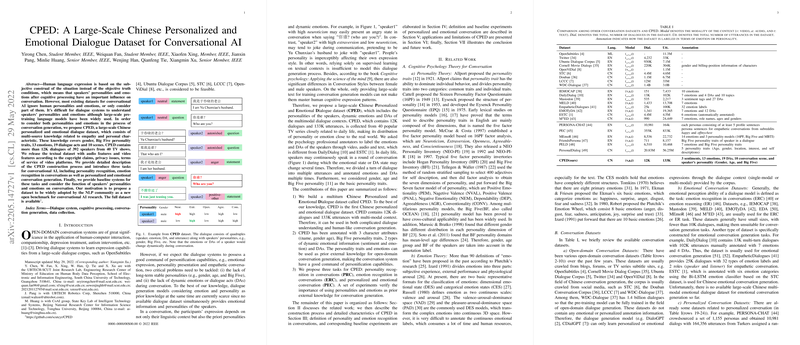An Expert Overview of "CPED: A Large-Scale Chinese Personalized and Emotional Dialogue Dataset for Conversational AI"
The paper introduces CPED, a comprehensive Chinese personalized and emotional dialogue dataset, aiming to bridge gaps in existing datasets that insufficiently integrate human emotional and personality dimensions within conversational models. This work is pivotal in the field of conversational AI, specifically addressing the nuance of human interlocution influenced by personality traits and varying emotional states.
Dataset Construction and Characteristics
CPED is meticulously structured from 40 TV shows and comprises over 12,000 dialogues across 392 speakers. The dataset incorporates multi-source knowledge elements related to empathy and personal characteristics, capturing nuances of human conversation through attributes like gender, the Big Five personality traits, 13 emotions, 19 dialogue acts, and 10 different context scenes. Each dialogue is labeled with relevant emotional and personality tags, providing a multidimensional representation of human conversation dynamics.
The dataset is notable for its meticulous annotation, carried out by professionals in cognitive psychology, ensuring high-quality and reliable emotion and dialogue act tagging. This quality of annotation is essential given the dataset's intended roles in nuanced cognitive and affective tasks within AI applications. Researchers receive the textual dataset along with audiovisual feature sets, adhering to privacy protocols and copyright constraints.
Novel Tasks and Benchmarks
The paper defines three specific tasks to harness the dataset's potential: (1) Personality Recognition in Conversations (PRC), (2) Emotion Recognition in Conversations (ERC), and (3) Personalized and Emotional Conversation Generation.
- Personality Recognition in Conversations (PRC): This task involves recognizing a speaker's personality traits across different conversations. The dataset provides a challenging environment for such tasks as it simulates real-world conversational complexity where personality may vary markedly across contexts.
- Emotion Recognition in Conversations (ERC): The dataset is employed to recognize emotions in a given dialogue, requiring models to integrate both temporal dialogue progression and implicit emotional cues. The benchmarks involve typical ERC models extended to capture the contextual interplay between utterance sentiment and dialogical flow.
- Personalized and Emotional Conversation Generation: This task underscores the dataset's utility in exploring new frontiers in dialog systems, particularly in generating responses that are empathetically tuned and aligned with individual personality traits. The baseline models vary from classical generative architectures to transformer-based systems, with a focus on incorporating explicit emotional and personality control signals.
Implications and Future Directions
CPED sets a new standard for conversational AI datasets by emphasizing the integration of emotional and personality dimensions. While previous datasets have largely ignored these human-centric attributes, CPED offers the foundational groundwork for developing and testing hypotheses in empathetic and personalized conversational AI systems. The implications are far-reaching, from enhancing interactive agents for mental health support to more relatable and adaptive AI-driven companionship.
The introduction of CPED may catalyze further research into multi-faceted models capable of understanding and generating human-like conversational experiences. In future developments, there could be significant strides in integrating the dataset with robust multimodal systems, furthering our understanding of how context, emotion, and personality dynamically interplay in human discourse.
Overall, this paper signifies an important step towards more sophisticated conversational AI, enabling systems to engage in interactions that are not only contextually appropriate but also emotionally and socially nuanced. The dataset serves as an open benchmark, encouraging community-driven advancements in conversational models that are rich, dynamic, and fundamentally human-like in their interactions.
